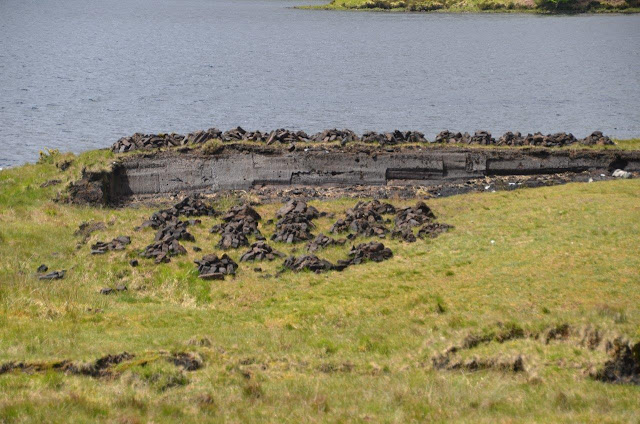Here you can see a farm with the fields behind surrounded by rock walls.
Some very nice looking houses.
And the rock walls go right up the sides of the hills.
We stopped for coffee at this fjord. It's one of three in Ireland and separates County Galway from County Mayo. It was formed by the glaciers which once covered Ireland and is 10 miles long and 150 feet deep.
Another example of the mountainous terrain
One of the primary sources of heat in the early days and still very popular is peat, what the Irish refer to as sod. Here you can see where a local farmer has been cutting the sod. The peat is many feet thick and has been built up over many thousands of years.
Lots of lakes. Beautiful but very barren.
One of the attractions in this area is Kylemore Abbey and here is a photo of it.
This abbey was originally built in 1867 by a wealthy London doctor who wanted it as a romantic castle for his wife and family in a quiet and beautiful location..That he got in spades as you can see here.
The original castle Victorian gardens have been restored and here are some photos I took as we walked through the gardens.
Here is the Tea Room where we had lunch.
High above the abbey is this shrine that had been built by the nuns.
We left the abbey and continued our travels through the peninsula. Came across this pretty little waterfall to the side of the road. Those are wild rhododendrons in the foreground. They were all over the place.
Another example of an isolated farm house.
Here is another example of sod cutting. They first scrape of the top growing layer and then use shovels and knives to cut the sod into small sections that they then stack to dry. A number of the shops had stacks of firewood and sod for sale for use in home fireplaces.
Another example of a beautiful lake.
Connemara is famous for its marble quarries and here are some examples of the colors it comes in.
And of course the gift shop. Pat bought a bracelet in sterling silver with inlaid pieces of marble in all of the colors that they quarry. They used to supply their marble for building construction but the supply has got so limited that they only use it for jewelry now.
We've finally arrived back in Galway and here is a view of Galway bay with the Aran islands on the horizon.
Here we are walking through the streets of Galway. This is the old section which dates back to 12th century.
What we found in the center of town was this former castle, now a bank, that had been built by the Lynch family in 1320. My paternal grandmother was a Lynch but who knows if we are descended from this Lynch family or not. Lynches were very important in Galway with James Lynch serving as the first mayor in 1484 and some 84 descendants held that position over the years. The Lynches were Norman and were part of the Norman invasion of Ireland starting in 1169. The Lynches originally lived in the town of Trim in County Meath but then later were part of the Norman force who conquered Galway in the 1230s.
After viewing the castle we went around the corner to the Church of St. Nicholas. This church was built in the late 13th century and was known to have been in use in 1320. Local lore is that Christopher Columbus visited this church prior to his visit to the new world and heard stories from the locals of what were thought to be Chinese sailors that had arrived during storms. It is now believed that they might have been Inuit from Greenland. Here is a photo of the church.
Here is a view of the main altar area.
And a close up of the stained glass window.
Here is the north Transept.
Here is the Nave of the church
The south Transept is known as the Lynch Transept and here is a tomb marker set into the wall.
For those having trouble reading the inscription, here is a translation.
Here is the Lynch coat of arms carved into a burial alcove.
This in one of two angels that had been carved into the alcove. It was defaced in 1652 by Cromwell's troops when they used the church as a stable for their horses.
Another Lynch tomb.
And here is the tomb of James Lynch who died in 1644. Being used today as a stage for readings and recitals.








































No comments:
Post a Comment